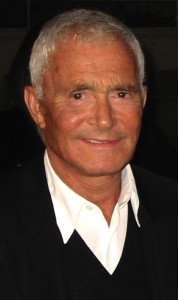
Today is the anniversary of Vidal Sassoon’s death (Jan 17, 1928 – May 9, 2012) and I am reminded of his profound life story overcoming adversity. One descriptive phrase he used about what he learned from a mentor in his life has always stood to out to me; the inconvenience of discipline.
Early Years

He was born in 1928 on the East End of London. During the Great Depression after his father abandoned his family, he along with his mother and brother moved to live with their widowed aunt and her three children in a two-bedroom flat. He later described their dwelling as “one of the tall, terrible tenements. The only toilet for four families was outside. You froze in January. You would hope that someone had just been to keep the seat warm.”[i]
Unrelenting poverty forced Sassoon’s mother to put him and his youngest brother in a Jewish orphanage for seven years.[ii] Their mother was only allowed to visit once a month and could never take them away from the orphanage; most of the time they were starving. In hindsight he observed that his brother “was always asking ‘why was I put in an orphanage?’ I never asked that. I knew she couldn’t help it. I accepted the situation. He did not.” Despite overwhelming obstacles, he refused to wallow in self pity and found a way to carry on and fight for success however he could. “‘In the final analysis my mother was proud of me.’”[iii]
Despite his love of soccer and passion to be a soccer player, at the age of eleven after being reunited with his mother he acquiesced to her insistence that he apprentice as a hairdresser instead. In England at the time, unless you were from a privileged family, then at the age of 14 you were finished school and began earning a living.
Apprenticeship: The Inconvenience of Discipline
“I was apprenticed to this wonderful man called Adolph Cohen on Whitechapel Road and what a disciplinarian he was! I was fourteen, it was 1942, and the war was on. Bombs were dropping practically every night, the Luftwaffe was giving London hell, and we still had to come in with our nails clean, our trousers pressed, and our shoes polished. Those two years with him definitely gave me the structure I needed in my life: the inconvenience of discipline.
“I took some time out after that because I still wasn’t sure if I wanted to be a hairdresser. I loved football [soccer] so much. In the end, I suppose it was the prospect of all the pretty girls and, of course, my mother that swung it for me. At first I couldn’t get a proper job in the West End of London at a big salon like Raymond’s because I had a cockney accent. That’s the way it was in those days.”[iv]
The Biggest Stars and Iconic Models
Knowing that his voice was limiting his potential, but determined to pursue his dreams, he took elocution lessons for three years to eliminate his cockney diction so that he could get a better job at one of the highly regarded salons. “I knew I had to learn how to project myself, so I got a job teaching in different salons in the evenings. I used my tips to take a bus to the West End and go to the theater. I’d catch the matinee and see the great Shakespearean actors like Laurence Olivier and John Gielgud and try to copy their voices.”[v]
Finally in 1954 London’s fashionable Bond Street saw its newest salon open. He and a business partner established a very small salon on the third floor of a building. “Bond Street was magic to me because it meant the West End. It was where I couldn’t get a job earlier. The West End meant I was going to make it. I was determined to change the way things were done or leave hairdressing.[vi] Despite a modest beginning, their success within two years enabled them to move to the “‘right’ end of Bond Street and compete with the top salons.” [vii] And compete they did.
His clients included some of the biggest stars, and iconic models of the 1960’s including Mary Quant, Jean Shrimpton and Mia Farrow. Inspired by Bauhaus architecture he spent nine years evolving his geometric style. He created the bob, the five-point (geometric) cut, and the Greek goddess style and revolutionized the beauty industry with wash and wear low maintenance hairstyles liberating women from salons. Hair rollers and helmet-style dryers become practically obsolete while the blow dryers he used to create his innovative hairstyles caused the novelty item to become a standard appliance in salons and homes.
Vidal Sassoon became “not only the first global name in hair care but the first person to put his name on products, to have a school; he is the man who paved the way for John Frieda, and Charles Worthington and Paul Mitchell. He is – no hyperbole –the Bill Gates of hair.”[viii] Ultimately, Sassoon became the founder of the $41 billion dollar hair care industry according to Datamonitor.
Are you wallowing in self pity always questioning what went wrong in your life? Perhaps you are not asking the right question. Instead of asking “why me?” try asking “how can I?’
Sassoon knew his accent was limiting his potential so he changed how he spoke in order to change his circumstances. What are you willing to change?
[i] http://vidalsassoonthemovie.com/press/TheSundayTelegraphSevenVSTM.pdf
Vidal Sassoon: The Movie –produced by Michael Gordon, the founder of Bumble and Bumble
[ii] http://vidalsassoonthemovie.com/press/TheSundayTelegraphSevenVSTM.pdf
[iii] http://vidalsassoonthemovie.com/press/TheSundayTelegraphSevenVSTM.pdf
[iv] The Element, Ken Robinson an Original Interview with Sassoon, p 164
[v] Robinson, p 164
[vi] Robinson, p 165
[vii] Robinson, p 166
[viii] http://vidalsassoonthemovie.com/press/FinancialTimesVidalSassoonTheMovie.pdf
